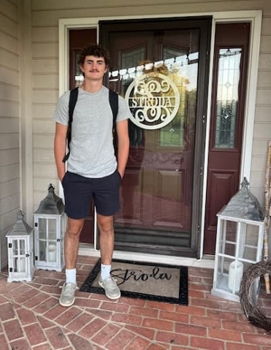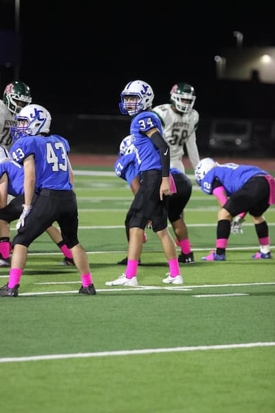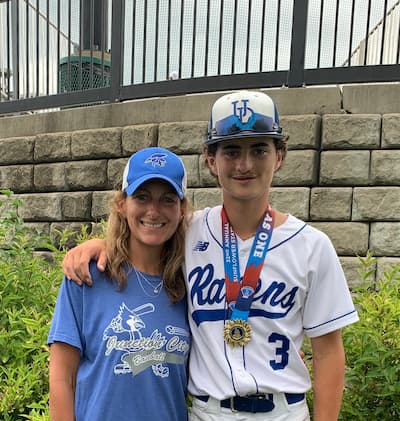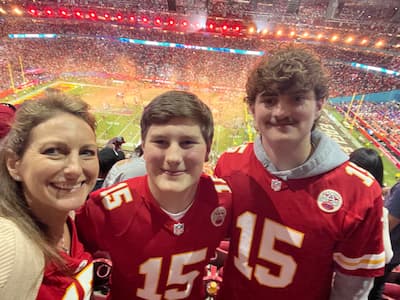Innovation is a Team Sport: How Children's Mercy Surgeons Tackled a Rare Tumor to Save a High School Athlete -Braedon's story
Meet Braedon

High school athletes are no strangers to the pain and injury that can come with intense competition. But when 16-year-old Braedon Stroda had ongoing neck and shoulder pain that was so severe he couldn’t sleep at night, he and his mom, Terrah, began a search for answers that would end in a series of first-of-their-kind surgeries at Children’s Mercy.
Braedon, who played football, baseball and wrestled for Junction City (Kan.) High School, is a focused, determined kid who loves hunting and fishing. “Braedon is my quiet, introverted kid,” said Terrah. “He can read the room and study people better than anyone I know.”
Terrah, who is a nurse midwife at Stormont Vail Hospital in Topeka, took Braedon to several different orthopedic and sports medicine specialists to try to find the source of his pain. “ We thought at first that it was a brachioplexus injury from wrestling,” Terrah recalled. “He would lose feeling in his left arm and hand off and on. It would get better, he’d be cleared for sports, and then end up in severe pain again.”
After months of dealing with this frustrating cycle, Braedon began to struggle with his mental health as well. “One night, we had a really tough, desperate 4 a.m. conversation,” Terrah shared. “Braedon was just begging me to fix the problem. The advocate in me just couldn’t give up on him.”
The Stroda family is full of fighting spirit. Terrah herself is a cancer survivor, but unfortunately her husband Brandon passed away from cancer in 2017. “Since the passing of Braedon’s dad, our family has a ‘don’t quit’ motto,” Terrah said. “You can’t sit in that hopelessness.”
Braedon himself has been a patient at Children’s Mercy since he was one week old. He was born with a cleft lip and palate and the Craniofacial team has performed 14 surgeries over the years to correct that. So while hospital life was nothing new for them, this situation felt different.
The search for answers continues

Terrah made Braedon an appointment with the Children’s Mercy Sports Medicine team, who suspected there was more than a sports-related injury at the root of Braedon’s pain and referred him to John Anderson, MD, in the Spine Clinic. More in-depth imaging studies showed an osteoid osteoma, a small, non-cancerous mass on his spine near the base of his skull.
“It was unclear at the time if the mass was contributing to the pain,” said Christian Kaufman, MD, FAANS, a neurosurgeon who was part of Braedon’s care team. “After very careful review, it started to make sense: Yes, it fits that this small benign lesion does seem to be a probable cause of his pain. But then the next big challenge is how do we get to this location, because it’s a very challenging one.”
Traditional surgical approaches to remove the mass on Braedon’s spine were very risky. “His mass was unique in that it was in a really difficult anatomic place,” said Douglas Rivard, DO, Executive Vice President and Physician-in-Chief and an interventional radiologist on Braedon’s care team. “Initially, we tried to access Braedon’s mass in radiology and [computerized tomography (CT)] and we just didn't have a good anatomic window. One of the main arteries that feeds the back of his brain was in the way, so we had to cut short that procedure and regroup.”
If at first you don’t succeed...

That first unsuccessful attempt to remove the mass in April 2023 was a big disappointment for Braedon, his family and his surgical team. However, Dr. Rivard was determined to find another way. He spent time reading, researching and thinking about Braedon’s situation while on a previously scheduled vacation shortly after the first attempt to remove the mass. When he came back to work, he pulled in several other Children’s Mercy specialists, including plastic surgeon Shao Jiang, MD, and additional members of the neurosurgery team. Together, they came up with a new plan.
Rather than entering through the back of the neck, Braedon’s team decided to try a trans-oral approach: going through the mouth. “As pediatric plastic surgeons who do cleft surgery, that’s an area that we typically can access pretty easily,” said Dr. Jiang. “So I just scrubbed in and used a special retractor for cleft lip and palate to open up the mouth and allow the neurosurgeons to use a neural navigation tool to pinpoint and access exactly where the lesion was.”
“Collaboration is the key to everything”
A trans-oral approach to the cervical spine is sometimes used for adults, but this was the first time the Children’s Mercy team had successfully used that strategy on a pediatric patient. All of Braedon’s doctors stressed that it was the collaboration and top-tier facilities at Children’s Mercy that made this unique surgery possible. “I think that our collegiality here is so good that we could pull aside any expert walking down the hall and say, ‘Hey, you know what, I have this particular clinical challenge, and I would appreciate if you could consider it,’” reflected Dr. Jiang.
Neurosurgeon Dr. Kaufman agreed. “It was a combination of multiple fields coming together to figure out how to use these new and innovative tools and ways to get there safely,” he said. “Collaboration is the key to everything — that's why it went so well,” he emphasized. The surgical team knew there were still risks to the alternative approach, but they felt that together, they could have a better chance at removing the painful mass.
Joyful tears
Terrah vividly remembers the moment Dr. Rivard came to update her after the second surgery in June of 2023: “He couldn’t get to me fast enough! He made a beeline for me and had a massive smile and said, ‘We got it!’” And we both had a moment. It was a very intense, phenomenal, inspiring moment for me to see that it actually worked.”
Braedon, on the other hand, wanted to see proof. Terrah recalls that as soon as he woke up, he insisted on seeing Dr. Rivard so he could know for sure that the mass was out.
Things improved significantly for Braedon after the procedure, and he was enjoying school, hunting and hanging out with his friends again. But a few months later, his pain started up again. The type of tumor Braedon had emits prostaglandin, a substance that causes bone pain. Even with only a tiny amount of tumor cells remaining, the tumor had continued to replicate itself and had grown back in the same area.
Third time’s the charm
“There was a big moment of a loss of hope,” Terrah shared. But true to their family’s fighting spirit, Terrah and Braedon returned to Children’s Mercy for new scans. Dr. Rivard, Dr. Kaufman and the team went back to the drawing board to find a way to tackle the persistent mass on Braedon’s spine. Together with Braedon and Terrah, the team decided to once again use the trans-oral approach to remove the tumor.
In March of 2024, Braedon had his third surgery to remove the osteoma. “The post-operative recovery was the worst this time,” Terrah recalled. Finally, a few weeks after the third surgery, “I got my kid back,” she said.
Braedon’s doctors were also glad to see a good outcome at last. “It’s especially gratifying on our end that we got to work together and do something really exceptional,” shared Dr. Rivard. And Dr. Jiang agreed: “It’s like putting a puzzle together. That last piece goes in there, you finally see the whole picture and it’s really amazing to know that each piece was where it was supposed to be.”
While he was relieved to have his pain under control, Braedon was deeply disappointed that many of the sports he loved were no longer safe for him to play due to the risk of injury to his neck. “He was a highly competitive, multi-sport athlete until he wasn’t,” Terrah shared. Baseball is the one sport he can still participate in, so for his senior year, he is shifting all his energy into that. “He’s also found there are other things to be a star at: Boys State, student government and student media at his high school,” Terrah said.
Moving forward
With his painful battle behind him at last, Braedon is looking ahead to his future. After he graduates in 2025, he plans to attend Kansas State University to major in engineering, with a particular focus on the medical side of engineering, such as surgical tools like the ones that helped him. “Dr. Rivard really inspired him to see how many options there are for medicine and research,” said Terrah.
Terrah is relieved to have this difficult journey behind them, too. For other families facing tough medical challenges, she said: “Just don’t quit. Listen to your child, but also reflect on what your goals are. Empower yourself to be the advocate for your child. You have to find the right team, which is why we continue to go to Children’s Mercy. They are the ‘don’t quit’ people!”

With the creativity, collaboration and connections Braedon’s care team brought to his unique case, the future looks bright for Braedon and many other kids who come to Children’s Mercy for their care. “Kids — even pretty big kids like Braedon — are not just small adults,” said Dr. Jiang. “This case expands the options and techniques that were developed in other age groups and for other indications and adapts them for pediatric use.” The surgical team plans to publish a case report and journal article to help other families who are looking for answers to a challenging medical situation.
“Braedon’s story wasn’t a pretty story,” Terrah said, “but it wasn’t his forever story. That’s what Children’s Mercy did — they never stopped until we got it all.”